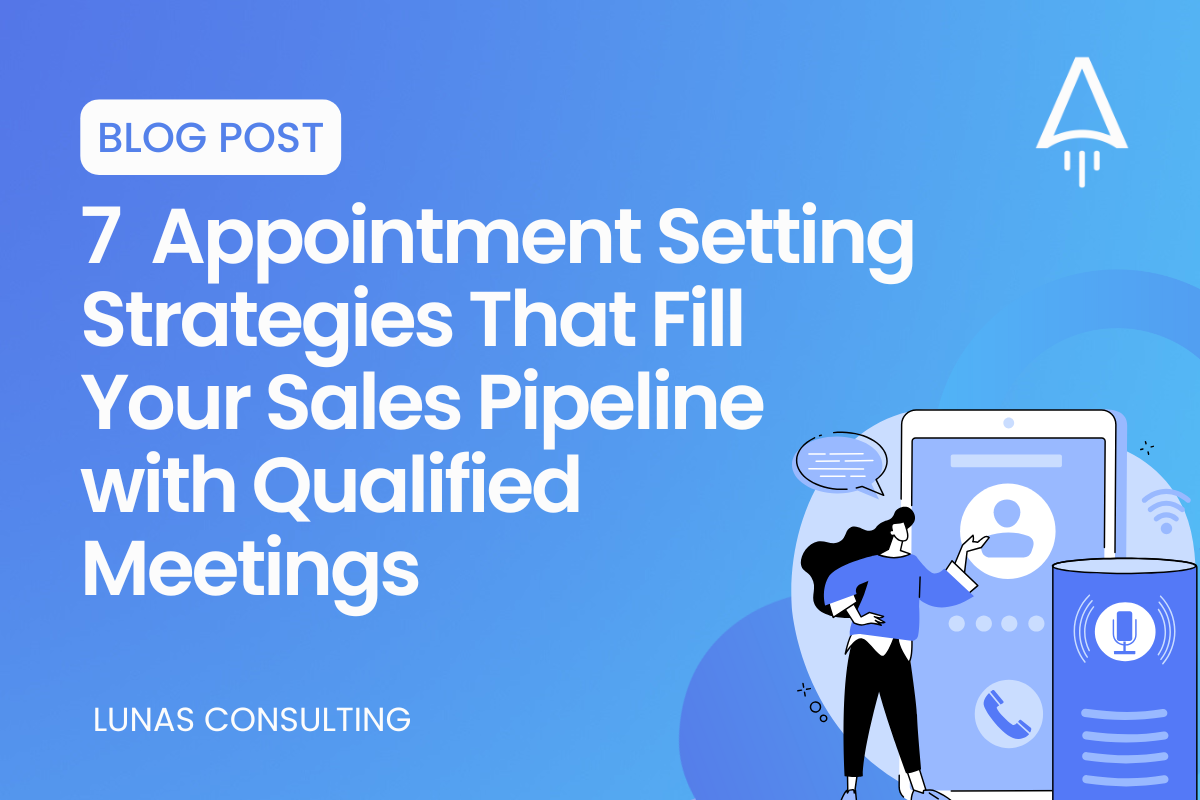7 Appointment Setting Strategies That Fill Your Sales Pipeline with Qualified Meetings
Master the art of appointment setting with seven proven strategies that leading B2B companies use to achieve higher show rates and more qualified opportunities.
Master the art of appointment setting with seven proven strategies that leading B2B companies use to achieve higher show rates and more qualified opportunities.

The brutal truth about B2B appointment setting? Without following best practices, you may experience no-show rates as high as 40% for B2B sales calls. That means nearly half your carefully scheduled meetings could evaporate into thin air, taking your team's time, energy, and potential revenue with them. Yet companies implementing strategic appointment setting practices are seeing dramatically different results, with some achieving show rates above 80% and converting significantly more opportunities into closed deals.
The appointment setting landscape has transformed radically in recent years. According to a study by Salesforce, 83% of sales professionals believe AI has already improved their ability to engage prospects effectively. Meanwhile, buyers have become more sophisticated, demanding personalized value from the very first interaction. The companies thriving in this environment aren't the ones making more calls; they're the ones making smarter connections through strategic, data-driven appointment setting approaches.
Before diving into strategies, let's clear up a common confusion that costs companies millions in misaligned efforts. Lead generation and appointment setting aren't the same thing, though many sales teams treat them interchangeably. Lead generation casts a wide net to identify potential buyers, while appointment setting surgically targets qualified prospects ready for meaningful sales conversations.
The distinction matters because each requires different skills, metrics, and technologies. Lead generation success might mean capturing 500 contact forms at a trade show. Appointment setting success means converting those contacts into 50 qualified meetings where real business discussions happen. One feeds the top of the funnel; the other accelerates deals through it.
5-10% of lower intent leads (content downloads, webinar attendees, etc), will convert to a meeting, while 75-80% of high-intent leads (demo requests, etc) will convert to a meeting. This massive gap illustrates why treating all leads the same way guarantees mediocre results. Your appointment setting strategy must recognize these differences and adapt accordingly.

The ROI comparison tells an even clearer story. While lead generation might cost $50-200 per lead depending on the channel, appointment setting costs can range from $500-1,500 per qualified meeting. However, that qualified meeting is exponentially more likely to generate revenue. Smart companies optimize both functions but recognize that appointment setting is where pipeline velocity really accelerates.
Success in appointment setting doesn't happen by accident. It requires a rock-solid foundation built on four pillars: target account identification, decision-maker mapping, value proposition alignment, and success metric establishment. Skip any of these, and your appointment setting efforts will crumble like a house of cards.
Target account identification goes beyond basic firmographics. The best appointment setters develop detailed account scoring models that factor in technographic data, intent signals, and organizational readiness indicators. They know not just who could buy, but who's actually likely to buy right now. This precision targeting dramatically improves both response rates and meeting quality.
Decision-maker mapping has become increasingly complex as buying committees expand. The average enterprise software purchase involves 6-10 decision makers consuming 13+ pieces of content across a 6-month evaluation period. Your appointment setting strategy must account for this reality by identifying not just the primary contact, but the entire constellation of influencers who will impact the buying decision.
Value proposition alignment separates amateur appointment setters from professionals. Generic pitches about "saving time and money" fall flat when everyone makes the same claims. Instead, successful appointment setters craft value propositions specific to each prospect's industry, role, and current challenges. They lead with insight, not product features, earning the right to a conversation by demonstrating immediate relevance.
The era of "Hi {{FirstName}}, I noticed you work at {{Company}}" personalization is dead. Today's buyers see through template-based outreach instantly, and they're ruthless about ignoring anything that feels mass-produced. Advanced personalization at scale requires a fundamentally different approach that combines human insight with technological leverage.
Personalization improves response rates by up to 30%, but only when it demonstrates genuine research and relevance. This means going beyond surface-level company information to understand recent initiatives, challenges, and opportunities specific to that organization. The best appointment setters reference earnings calls, industry reports, and competitive moves to demonstrate they've done their homework.
Implementation requires a systematic approach to research and messaging customization. Start by building research templates that capture consistent insights across prospects: recent funding, technology stack changes, leadership transitions, and market positioning. Then create modular messaging components that can be mixed and matched based on these insights. This approach allows personalization without starting from scratch for every prospect.
A tip from us: Create a personalization hierarchy that prioritizes research effort based on account value. Enterprise accounts might warrant 30 minutes of research per prospect, while SMB targets get 5 minutes. This ensures you're investing personalization effort where it generates the highest return.

Technology enables this strategy to scale beyond what human effort alone could achieve. Sales intelligence platforms now use AI to surface relevant triggers and talking points automatically. Dynamic content tools can assemble personalized messages from component parts based on prospect attributes. The key is maintaining authentic human voice while leveraging technology for efficiency.
You may also be interested in: Building a High-Performance SDR Team That Consistently Books Qualified Meetings
Data quality determines appointment setting destiny. You can have the world's best sales team, but if they're calling disconnected numbers and emailing role-based addresses, failure is guaranteed. Strategic data enrichment transforms your prospect database from a list of names into an intelligence goldmine that powers successful outreach.
The appointment scheduling software market was valued at USD 332.8 Million in 2024 and is projected to reach USD 891 Million by 2032, partly driven by the integration of better data intelligence capabilities. Modern appointment setting requires multiple data layers: firmographic for company context, technographic for solution fit, intent data for timing, and contact verification for deliverability.
The data enrichment process should be continuous, not one-time. Companies change, people move, and technologies evolve. Set up automated enrichment workflows that refresh data points monthly for active prospects and quarterly for broader databases. Pay special attention to mobile phone numbers, as getting the prospect's cell phone number allows you to text them personalized meeting reminders, significantly reducing no-shows.
Compliance considerations can't be ignored in today's regulatory environment. GDPR, CCPA, and industry-specific regulations create a complex web of requirements around data collection and usage. Build compliance into your enrichment process from the start, maintaining clear documentation of data sources and consent mechanisms. This protects your company while also building trust with prospects who increasingly care about data privacy.
Timing isn't everything in the appointment setting, but it's pretty close. The difference between reaching out when a prospect is actively evaluating solutions versus when they're heads-down on other priorities can mean the difference between a booked meeting and radio silence. Trigger-based outreach ensures you're always striking while the iron is hot.
50% of sales go to the first salesperson to speak to the prospect, making rapid response to triggers absolutely critical. Company triggers like funding announcements, leadership changes, and expansion indicators signal organizational readiness for change. A new VP of Sales might be eager to evaluate new tools. A company opening a new office might need additional vendors. These triggers create natural conversation starters that feel relevant rather than intrusive.
Personal triggers often get overlooked but can be even more powerful. A prospect who just got promoted has budget authority they didn't have before. Someone who changed companies brings vendor relationships from their previous role. Someone who just published a LinkedIn article about their challenges is literally broadcasting their priorities. Smart appointment setters monitor these personal signals as closely as company ones.
Implementing trigger-based strategies requires both technology and process. Set up monitoring systems that alert you to relevant triggers in real-time. Create rapid response protocols that enable outreach within hours, not days, of trigger events. Develop trigger-specific messaging frameworks that acknowledge the trigger naturally while pivoting to your value proposition. The key is being helpful and timely, not opportunistic and pushy.
Single-channel outreach is like fishing with one line when you could be using a net. Modern buyers interact across multiple channels throughout their day, and your appointment setting strategy must meet them wherever they are. But multi-channel doesn't mean omni-channel spam; it means coordinated, strategic touches that build toward a conversation.

Sending a short, personalized video message through LinkedIn or email not only sets you apart but also builds a more personal connection, enhancing the trust factor. Each channel has unique strengths: email for detailed value propositions, LinkedIn for social proof and warm introductions, phone for immediate engagement, and video for personality and differentiation. The magic happens when these channels work in concert.
Sequencing matters as much as channel selection. A typical orchestrated campaign might start with a LinkedIn profile view to signal interest subtly, followed by a connection request with a personalized note, then an email with valuable insights, a phone call referencing the previous touches, and finally a video message if earlier attempts haven't connected. Each touch builds on the previous ones, creating familiarity and demonstrating persistence without annoyance.
The data supports this orchestrated approach. Activities to Reach a Prospect: Now requires 19 activities, up from just over 10 attempts previously. This isn't about mindlessly increasing volume; it's about strategically layering touches across channels to maximize the probability of meaningful connection. Track response rates by channel and sequence position to continuously optimize your orchestration.
You may also be interested in: Critical Outsourced Sales Mistakes That Sabotage Business Growth and How to Fix Them
The logistics of appointment setting can kill deals before they even begin. Between time zone confusion, calendar conflicts, and the back-and-forth of finding mutual availability, many qualified prospects simply give up. AI-assisted scheduling eliminates this friction, making it effortless for prospects to commit to meetings.
Over 46% of appointments are booked online, which significantly reduces the burden on staff, and this percentage continues climbing as buyers increasingly expect self-service options. Modern scheduling tools go beyond basic calendar matching to optimize for show rates and conversion probability. They can automatically suggest times when prospects are most likely to attend, buffer time for preparation, and even adjust for cultural preferences in different regions.
A tip from us: Implement scheduling links that automatically populate with prospect-specific information and adjust available times based on the prospect's industry and typical meeting patterns. A CFO might prefer early morning slots, while a CMO might engage better in afternoon creative sessions.
The integration capabilities of modern scheduling platforms transform appointment setting efficiency. When scheduling tools connect with your CRM, marketing automation, and sales engagement platforms, magical things happen. Meetings automatically get logged with full context, follow-up sequences trigger based on meeting outcomes, and team members receive briefing documents without manual intervention. This automation frees appointment setters to focus on high-value activities rather than administrative tasks.
The traditional "I'd like 15 minutes of your time to show you our product" approach is dead. Today's buyers have zero patience for vendor-centric pitches. The value-first discovery approach flips the script, leading with insights and expertise that earn the right to a deeper conversation.
Educational offers consistently outperform sales pitches in securing appointments. Position your meeting as a consultation, assessment, or strategy session rather than a sales call. Offer to share industry benchmarks, conduct a brief audit, or provide customized recommendations based on your expertise. This reframing transforms the meeting from a cost (the prospect's time) to an investment (valuable insights gained).
The first 7 seconds are crucial in any outreach attempt, and how you position the value of the meeting matters more than ever. Instead of "I want to tell you about our solution," try "I've helped three similar companies reduce customer churn by 23% and would love to share what worked for them." This approach demonstrates expertise while promising tangible value.
Crafting compelling meeting invitations requires careful attention to every element. Subject lines should intrigue without misleading. The body should be scannable with clear value points. The ask should be low-commitment, perhaps starting with a brief call before committing to a longer meeting. Social proof elements like client logos or brief case study mentions build credibility. Every word should focus on what the prospect gains, not what you want to pitch.

The dirty secret of appointment setting? Many booked meetings shouldn't happen at all. Without proper qualification, you waste everyone's time on conversations with prospects who lack budget, authority, need, or timeline. Strategic qualification ensures every meeting has genuine potential while respecting both parties' time.
Outbound SDRs produce 15 meetings a month, with an 80% show rate, leading to 12 meetings held per month when proper qualification is in place. This high show rate doesn't happen by accident; it results from rigorous pre-qualification that confirms mutual fit before the meeting is even scheduled.
Pre-qualification frameworks like BANT (Budget, Authority, Need, Timeline) provide structure, but modern appointment setting requires more nuanced qualification. Consider MEDDIC (Metrics, Economic buyer, Decision criteria, Decision process, Identify pain, Champion) or SPICED (Situation, Pain, Impact, Critical Event, Decision) for complex B2B sales. The key is adapting your framework to your specific sales process and buyer journey.
Pre-meeting preparation transforms good meetings into great ones. Create detailed briefing documents that synthesize everything you know about the prospect, their company, and their challenges. Develop customized agendas that align with their specific interests. Prepare relevant case studies and references. Send pre-meeting materials that allow prospects to come prepared with questions. This preparation demonstrates professionalism while accelerating the sales conversation.
Modern prospecting transcends the traditional cold outreach model. Account-based prospecting, social selling, referral strategies, and content-driven approaches each play crucial roles in filling the appointment calendar with qualified meetings. The key lies in integrating these techniques into a cohesive strategy rather than treating them as separate initiatives.
Account-based prospecting aligns appointment setting with broader go-to-market strategies. Instead of casting a wide net, you focus intensive effort on a defined set of high-value accounts. This concentration allows for deeper research, more personalized outreach, and coordinated multi-threading across the buying committee. The investment is higher, but so is the return when you land these strategic accounts.
Social selling has evolved from a buzzword to a critical appointment setting channel. Prospects are more likely to respond to video pitches, especially when delivered with genuine enthusiasm. LinkedIn provides unprecedented access to decision-makers, but success requires more than connection requests and InMail blasts. Build genuine relationships by engaging with prospects' content, sharing valuable insights, and establishing thought leadership in your space.
Content-driven prospecting creates inbound interest that makes appointment setting easier. When prospects consume your content before the first outreach, they come pre-educated and pre-qualified. Track content engagement to identify high-intent prospects, then use that engagement data to personalize your outreach. "I noticed you downloaded our guide on X" is far more compelling than a cold introduction.
You may also be interested in: Transforming Cold Leads into Sales Opportunities Through Strategic Sequence Design
What gets measured gets managed, but measuring the wrong things manages you into the ground. Vanity metrics like number of dials or emails sent tell you nothing about appointment setting effectiveness. Focus instead on metrics that directly correlate with revenue generation and sales success.
Cold call generated sales appointments typically have a show rate of around 40-50%, while MQL converted appointments tend to have 60-70% show rates, and referral generated appointments often exceed 80%. Track show rates by source to optimize your channel mix. If certain sources consistently generate no-shows, either improve qualification for that source or redirect effort elsewhere.
Meeting-to-opportunity conversion reveals appointment quality beyond just show rates. A 100% show rate means nothing if none of those meetings progress to real opportunities. Set targets for this metric based on your sales cycle and average deal size. Generally, at least 30-40% of held meetings should convert to qualified opportunities, though this varies significantly by industry and price point.
Velocity metrics matter as much as volume metrics. Schedule calls to be held as soon as possible, preferably within 5 business days and certainly no more than 10 business days out. Track time from first touch to meeting scheduled, and from meeting scheduled to meeting held. Longer gaps correlate with lower show rates and reduced conversion probability.
The right technology stack can multiply appointment setting productivity by 5-10x, but the wrong stack becomes an expensive distraction. Building an integrated system requires careful selection of complementary tools that work together seamlessly rather than creating additional silos.
The appointment scheduling software market is growing at a CAGR of 13.10% from 2026 to 2032, reflecting rapid innovation in this space. Modern appointment setting requires several core technology categories: CRM for data management, sales engagement platforms for multi-channel orchestration, data intelligence tools for enrichment and triggers, and scheduling software for frictionless booking.

Integration is everything in your technology stack. When your sales engagement platform automatically logs activities to your CRM, which triggers your scheduling tool to offer availability, which then updates your calendar and creates a briefing document, you've achieved technology stack nirvana. Each additional integration eliminates manual work and reduces the chance for human error.
The selection criteria for appointment setting technology should prioritize usability and adoption over feature completeness. The most sophisticated platform in the world provides zero value if your team won't use it. Start with core functionality that addresses your biggest pain points, then expand capabilities as your team develops proficiency. Remember that technology enables strategy; it doesn't replace it.
Growing appointment setting from a single SDR to a full team requires systematic approaches to maintain quality while increasing quantity. The challenges of scaling include maintaining consistency across team members, preserving personalization at volume, and ensuring technology infrastructure can support growth.
Process documentation forms the backbone of scalable appointment setting. Create detailed playbooks covering every aspect of the appointment setting process: research methodologies, outreach templates, objection handling scripts, and qualification frameworks. But avoid the trap of over-documentation that stifles creativity. The goal is consistency in quality, not robotic uniformity.
Quality control systems become critical as volume increases. Implement call recording and review processes, shadow booking sessions for new team members, and create peer review systems where team members critique each other's outreach. Regular calibration sessions ensure everyone maintains the same high standards regardless of individual style differences.
The build versus buy decision looms large as you scale. In-house teams provide control and deep product knowledge but require significant investment in hiring, training, and management. If the average annual SDE is $150,000 or $12,500 per month, and the average number of monthly appointments across all industries is eight, one meeting would cost $1,562.50. Outsourced appointment setting services can provide immediate scale and expertise but may lack the nuanced understanding of your specific market. Many companies find success with a hybrid model, using internal teams for strategic accounts and external partners for broader market coverage.
You may also be interested in: Understanding Sales Sequences and Marketing Automation for Maximum Lead Conversion
The seven strategies outlined here represent the evolution of appointment setting from brute force activity to strategic revenue generation. Companies implementing these approaches systematically see dramatic improvements in show rates, meeting quality, and ultimately, closed deals. The key lies not in choosing one strategy but in orchestrating all seven into a comprehensive appointment setting machine.
Local businesses increased their revenue by 120% after adding online booking systems to their website, demonstrating the transformative power of modern appointment setting approaches. While your results may vary, the direction is clear: companies that master appointment setting in 2025 will dominate their markets while others struggle to get prospects on the phone.

Start by auditing your current appointment setting process against these seven strategies. Identify the biggest gaps and prioritize fixes based on potential impact. Remember that perfection isn't the goal; consistent improvement is. Even implementing one or two of these strategies effectively can dramatically improve your appointment setting results and fill your pipeline with qualified meetings that actually close.
Interested in improving your skills and learning more about business operations to generate and convert leads? Check out the following articles:
Essential Online Presence Tools Every Business Owner Should Use in 2025
Why Small Businesses Need a Strong Online Presence to Survive and Thrive
How Your Online Presence Functions as Your Most Powerful Business Card
Building a Loyal Online Following Through Strategic Social Media Consistency
How Social Media Transforms Your Digital Strategy and Online Business Growth
10 Time-Saving Strategies for Effective Business Updates Across Social Media Platforms
References:
RevNew - B2B Appointment Setting Cost Guide 2025
PMG-B2B - B2B Appointment Setting Techniques for 2025
Gungho Global - Sales Appointment Setting Statistics Comparison
Verified Market Research - Appointment Scheduling Software Market Report
RevNew - B2B Appointment Setting Best Practices 2025
SMB Guide - Appointment Scheduling Statistics 2025
Gradient Works - B2B Sales Benchmarks 2024
LinkedIn - Reducing B2B Sales Call No-Show Rates
We have a lot more for you. Click the button below to sign up and get notified when we release more content!
View more